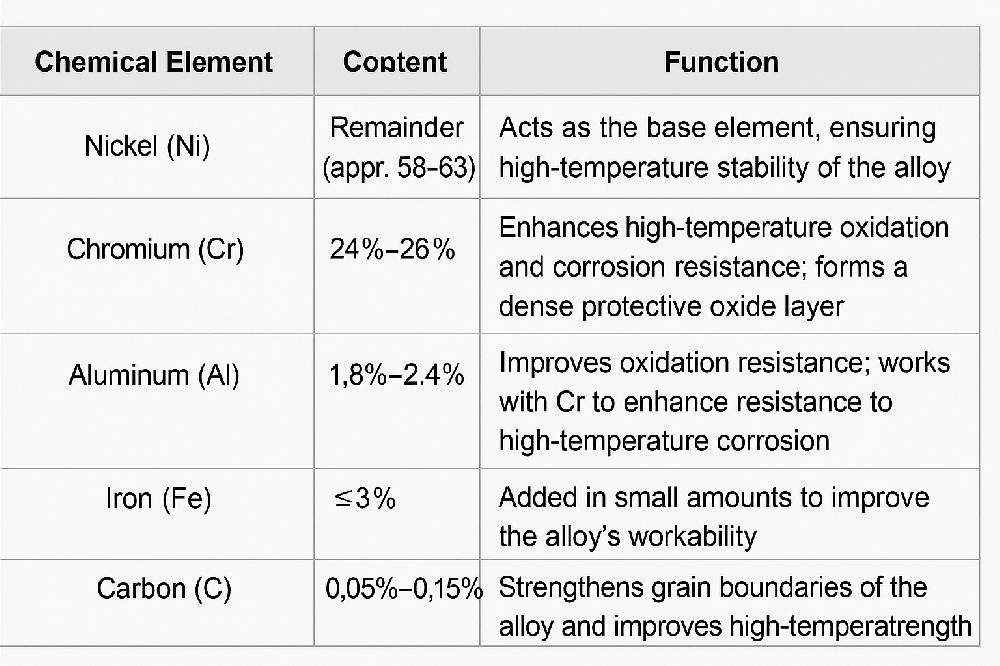Introduction to 602CA Material
It is a high-performance nickel-based superalloy, commonly referred to as "Alloy 602 CA" (also written as 602CA alloy). Primarily composed of nickel with additions of chromium, aluminum, and other elements, it exhibits excellent high-temperature oxidation resistance, high-temperature strength, and corrosion resistance, making it widely applicable in high-temperature industrial fields. Below is a detailed introduction covering its composition, properties, and applications:
1. Basic Composition
The typical chemical composition of 602CA (wt%) is as follows:

Other trace elements, such as titanium (Ti ≤ 0.1%) and zirconium (Zr ≤ 0.1%), further optimize grain boundary performance and oxidation resistance.
2. Key Properties
High-Temperature Oxidation Resistance
602CA can form stable Cr₂O₃ and Al₂O₃ oxide films at high temperatures (up to 1100-1200°C), effectively preventing further oxygen penetration into the base material. It performs exceptionally well in environments containing corrosive gases like sulfur and carbon dioxide, with an oxidation resistance lifespan far exceeding that of ordinary stainless steel or low-alloy heat-resistant steel.
High-Temperature Strength and Creep Resistance
In the range of 600-1000°C, 602CA exhibits high tensile strength and creep resistance (the ability to resist slow deformation under sustained load at high temperatures), making it suitable for long-term high-temperature load-bearing applications.
Processability
It can be processed through forging, rolling, welding, and other methods. However, due to its high high-temperature strength, cold working requires careful control of deformation, and welding should use compatible high-temperature alloy filler wires (e.g., ERNiCr-3) to avoid hot cracking.
Corrosion Resistance
It demonstrates good resistance to high-temperature sulfides, chlorides, and other corrosive media, while maintaining stability in both oxidizing and reducing atmospheres.
3. Main Applications
Thanks to its outstanding high-temperature performance, 602CA is primarily used in the following scenarios:
Industrial Furnace Components: Such as furnace plates, rollers, heating element supports, and radiant tubes, suitable for high-temperature heat treatment furnaces and ceramic sintering furnaces.
Energy Sector: Combustion chamber components for gas turbines and high-temperature heat exchangers (e.g., waste heat boiler tubes).
Environmental Equipment: High-temperature corrosion-resistant parts in waste incinerators and waste treatment systems.
Chemical Industry: High-temperature reactors, catalyst carriers, and other applications, particularly in reaction environments containing sulfur or oxidizing atmospheres.
4. Comparison with Similar Alloys
Compared to common nickel-based superalloys (e.g., Inconel 600, Haynes 230), 602CA stands out for:
Superior oxidation resistance (due to higher aluminum content), making it suitable for higher-temperature oxidizing environments;
Lower cost than some high-end nickel-based alloys, offering better cost-effectiveness;
Slightly lower high-temperature strength than alloys like Haynes 230 but excelling in scenarios where oxidation resistance is the primary requirement.
5. Precautions
Prolonged exposure to high temperatures may cause "age hardening" in 602CA. Avoid extended stays in the 650-850°C range to prevent increased material brittleness.
Post-welding heat treatment (e.g., solution treatment at 1050-1100°C) is recommended to relieve welding stress and restore oxidation resistance.

